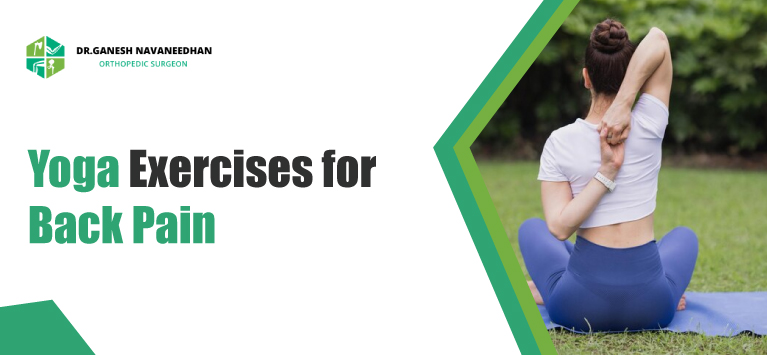- +91 8848509072
-
Sasthamangalam, Trivandrum
Sasthamangalam, Trivandrum

Have you ever wondered if something as simple as yoga holds the key to relieving your back pain? Back pain is a common issue that can impact people of all ages and activities. Stress, bad posture, and sedentary work are frequently responsible for this discomfort. Although there are many therapies available, including yoga in your practice can be a comprehensive and successful strategy for controlling and avoiding back pain.
However, what if a few simple yoga positions were the answer to the back pain you’ve been looking for while balancing your day-to-day challenges? This blog explores the benefits of yoga for back pain, including the mechanisms by which the poses work, the significance of yoga, and the ways in which yoga relieves back pain.
It is important to know the common causes of back discomfort before beginning any yoga practice. Lack of exercise, sedentary lifestyle, and bad posture are frequently the cause. Other symptoms include muscular imbalances, tightness, and weakening of the core muscles.
Improves Flexibility: The back’s muscles, ligaments, and joints are stretched and mobilised by yoga poses, which increases the range of motion and flexibility. This enhanced flexibility can reduce pain and spasms in the muscles.
Strengthens Core Muscles: The muscles in the lower back and abdomen are part of the core, which is responsible for maintaining the spine. Targeting these muscles in yoga poses strengthens them, stabilising the spine and lowering the chance of back pain.
Enhances Posture: Back pain can often be caused by poor posture. Yoga promotes healthy body mechanics and aligns the spine to help correct postural abnormalities. Proper posture eases pain by minimising strain on the back’s joints and muscles.
Reduces stress and anxiety: Back pain can be made worse by anxiety and stress. Yoga integrates relaxation and mental calmness through the use of breathing exercises and meditation techniques. Yoga can help with back pain indirectly by reducing stress.
Begin with simple poses like Child’s Pose, Cow, and Downward-Facing Dog pose to ease yourself into a yoga practice. Building a connection with your body requires focus and deep breathing.
Gradually add longer sessions and more challenging poses as you get more at ease. Please pay attention to your body’s signals, respect its limits, and stop straining yourself too quickly or too hard. A trained yoga instructor may offer individualised assistance and guarantee safe growth by consulting with them.
Cow Pose enhances spinal mobility as well as flexibility while supporting stress release and strengthening the core muscles.
Steps:
One-Legged King Pigeon Pose opens the chest and shoulders, releases tension, and promotes hip and lower back flexibility. It also stretches the hip flexors and quadriceps deeply.
Steps:
By strengthening the arms, shoulders, and core and stretching the entire spine, hamstrings, and calves, downward-facing dog asana relieves back pain and increases general body strength and flexibility.
Steps:
In Half Lotus Christ Pose, hip opening with a gentle backbend works together to strengthen the thighs, hips, and lower back. It also helps to ease stress in the spine and encourage relaxation.
Steps:
Child’s Pose eases stress and calms the mind by stretching the legs, hips, and spine. Relaxes the back and shoulders, relieves strain in the spine, and improves digestion.
Steps:
Bird Dog posture, also referred to as the Balancing Table pose, helps to improve posture and total body coordination by strengthening the core muscles, stabilizing the spine, and enhancing balance.
Steps:
One Knee to Chest Pose releases strain in the lower back, hips, and glutes while encouraging relaxation and increasing hip and spine flexibility.
Steps:
A posture that reaches both knees to the chest eases lower back pain and stiffness by massaging the spine and encouraging relaxation. It also improves digestion and eases discomfort.
Steps:
Bridge Pose improves spinal flexibility, opens the chest, and strengthens the back and glutes. It also helps with back pain relief and posture.
Steps:
Plow Pose, also known as halasana, stimulates the thyroid gland, improves metabolism, and relaxes the mind while stretching the neck, shoulders, and spine.
Steps:
Beyond the physical postures, pranayama (deep breathing) and awareness can improve the therapeutic effects of yoga on back pain. In order to relieve stress and tension that could be causing back pain, one can practise deep, diaphragmatic breathing. This soothes the neurological system.
Consistency is key when using yoga to manage back pain. As your flexibility and strength increase, think about incorporating these postures into your daily routine and gradually increasing the duration and intensity.
Back pain can be effectively relieved and prevented with the help of yoga. People can improve their general well-being and support a pain-free, healthy back by using physical poses, mindful breathing, and a routine of practising yoga.
Remember to consult with a healthcare professional before starting any new exercise routine, especially if you have pre-existing conditions or concerns about your back health. With dedication and a mindful approach, yoga can become a valuable tool in your journey toward a healthier, pain-free back.
Copyright © 2024 Dr. Ganesh Navaneedhan. All Rights Reserved. | Designed By Harvee healthcare